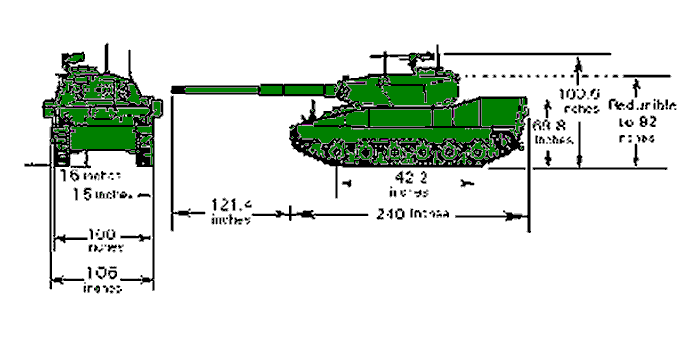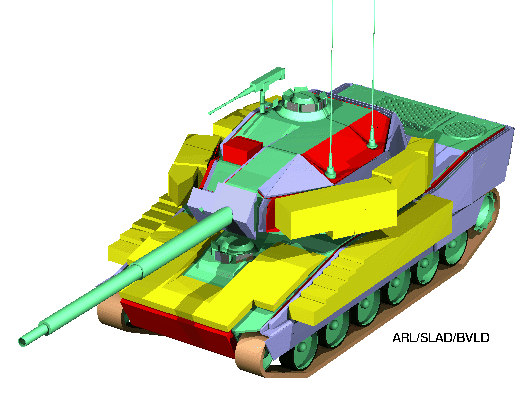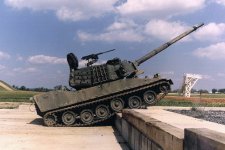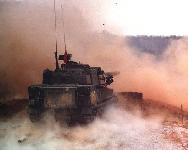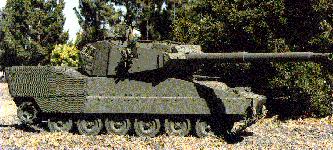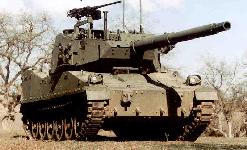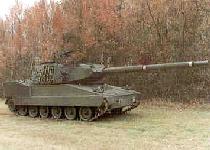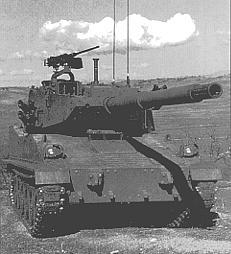 The FMC XM8 was designed to combine a tank's firepower with a highly mobile, air-droppable
vehicle. AGS was intended to be the Army's new combat vehicle, but in the form of a highly deployable, light-weight vehicle, with high fire-power and reconfigurable armor protection. The AGS was intended to replace the M551A1 Sheridan in the 82nd Airborne Division, and was expected to replace TOW-equipped HMMWVs in the 2nd Armored Cavalry Regiment (Light). A total of 237 systems were planned for procurement.
The cancellation of the M8 Armored Gun System left the US Army airborne forces dangerously low on firepower.
The FMC XM8 was designed to combine a tank's firepower with a highly mobile, air-droppable
vehicle. AGS was intended to be the Army's new combat vehicle, but in the form of a highly deployable, light-weight vehicle, with high fire-power and reconfigurable armor protection. The AGS was intended to replace the M551A1 Sheridan in the 82nd Airborne Division, and was expected to replace TOW-equipped HMMWVs in the 2nd Armored Cavalry Regiment (Light). A total of 237 systems were planned for procurement.
The cancellation of the M8 Armored Gun System left the US Army airborne forces dangerously low on firepower.
The M8 is the result of the Armored Gun System (AGS) concept that originated in the early 1980s to provide light forces with more powerful direct support. In 1980 the Army's 9th Infantry Division was selected as the test unit for the new High Technology Light Division (HTLD). The HTLD was designed to fight in the deserts of Southwest Asia. Critical pieces of equipment needed to realize the division concept were never available. The Army was only able to field prototypes of some key pieces of the high technology equipment. In other cases, such as the Armored Gun System (AGS), it could not even field prototypes. The AGS was never successfully developed. The substitutes did not provide the capabilities envisioned by the original concepts. These failures hamstrung the division's development.
The M8 resembles a conventional tank, but only requires a crew of three through the use of an autoloader. Its main armament is a 105mm Rheinmetall XM35 tank gun. The M-35 cannon is a low-recoil gun that allows the use of previously developed 105mm ammunition. The autoloader holds 21 projectiles with nine more stowed forward near the driver. Fire control is provided by a digital fire control system with microprocessors and a databus similar to that on the M1A2. The gunner's primary sight is a day/night thermal sight and integrated laser range-finder in a stabilized mount.
Its unique features include an autoloader for the main gun, a three-man crew. and the use of modular appliqu� bolt-on armor that is not used in a load-bearing application. The armored gun system used titanium appliqu� armor. The M8 can be fitted with three levels of protection:
- Level I against splinters
- Level II against armor piercing small arms and small cannon fire
- Level III against cannon up to 30mm
In 1980 the Army established a need for a Mobile Protected Gun System (MPGS) to support its light divisions. Although an organizational and operational plan was developed, further actions on the MPGS program were deferred in 1982. A ROC document for the AGS was approved by the Army in 1985, but the AGS could not be sufficiently funded and was terminated in 1987. In 1989 the Commander, XVIII Airborne Corps, stated the need to replace the M551A1 Sheridan, and he endorsed the 1985 AGS ROC as needing only minor revisions to meet his requirements.
The revised AGS ROC was approved by the Army in September 1990, followed shortly thereafter by the DAB approval of its acquisition as a non-developmental item. After a market survey indicated that nothing "off the shelf" would satisfy the ROC, the Army Systems Acquisition Review Council (ASARC) in May 1992 approved a program, beginning with EMD, to develop and produce the AGS. FMC, now part of United Defense Limited Partnership (UDLP), was the winning contractor. A program restructuring in FY94 to reduce program concurrence also decreased the number of LRIP systems and slipped first unit equipped (FUE) by about 2 years.
In 1993 survivability test assessments were initiated the Armored Gun System. Early live fire tests for this program either demonstrated that the initial AGS design meets its requirements or provided data to support design fixes. One design feature that resulted in a 'surprise' outcome was the ammunition compartment feature that failed to contain the reaction of the ammunition when struck by realistic threat weapons.
The AGS is not a tank -- it may look like a tank, but it's not a tank. It's a thin-skinned vehicle with a gun on it. The vehicle was designed to support the infantry from a position where it can fire and be behind dirt with an elevated gun and to fight in areas where its not going to run into tanks. It has more than one role, and it just doesn't kill tanks. It kills other kinds of targets. It has to be able to bust bunkers, shoot into bunkers, go into urban areas and shoot into windows, and have a round that will spray shrapnel -- that will "take out" people who are firing hand-held weapons or machine guns. US forces using enhanced direct-fire weapons such as the Armored Gun System would fare better than forces equipped with current firepower.
In the fiscal 1996 budget the Armored Gun System was slated to enter production. The Army's Armored Gun System was terminated in 1996, and the FY 97 budget abandoned the Armored Gun System program. When the Army submitted its proposed fiscal 1997 budge, Defense Secretary William Perry instructed the service to plan for an additional cut of 20,000 troops to pay for weapons modernization. Rather than accept a cut from 495,000 to 475,000 troops, Army leaders argued they could obtain the necessary modernization funds through acquisition reforms and operating efficiencies. The fiscal 1997 Defense budget request contained no further Army troop cuts, but the Army cut the AGS program in an attempt to save money for other modernization efforts. The decision was made by the Army as part of an assessment of the warfighting value of the armored gun system compared with alternatives and how they could do it spending less funds. The total program cost, including development, was estimated to be $1.3 billion. The Army had planned to procure 26 low-rate initial production vehicles with 1996 funding of $142.8 million. Termination liability was funded from research and development appropriations because the program was under an engineering and manufacturing development contract. The Armored Gun System is an example of a program in which manpower and personnel integration [MANPRINT] considerations were purposely rejected. It is not a coincidence that the Army canceled the program.
The AGS chassis was also intended to serve as the platform for the hypervelocity line-of-sight antitank (LOSAT) missile system, and building the chassis for the LOSAT alone would be rather expensive.



